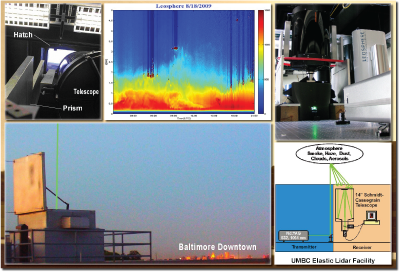Using Light Detection Technology to Examine Air Quality
Main_Content
 The Department of the Environment uses lidar (light detection and ranging) to help understand how particles mix vertically in the atmosphere over time.
Particles can be transported locally or travel hundreds of miles or more before reaching Maryland. This instrument can track particles mixing down toward the surface, which can warn Department meteorologists of potential poor air quality for daily
air quality forecasts and can also be used to look at past poor air quality episodes. Smoke from wildfires that contains particle pollution, for instance, can be identified using lidar. An
example of lidar data illustrates how particles can be seen mixing down toward the surface.
The Department of the Environment uses lidar (light detection and ranging) to help understand how particles mix vertically in the atmosphere over time.
Particles can be transported locally or travel hundreds of miles or more before reaching Maryland. This instrument can track particles mixing down toward the surface, which can warn Department meteorologists of potential poor air quality for daily
air quality forecasts and can also be used to look at past poor air quality episodes. Smoke from wildfires that contains particle pollution, for instance, can be identified using lidar. An
example of lidar data illustrates how particles can be seen mixing down toward the surface.
These measurements are particularly useful in examining the lowest layer of the atmosphere, called the boundary layer. Lidar uses a laser to measure distance by illuminating an atmospheric target like particles or water vapor and analyzing the light that reflects back to its sensor, called backscatter. The Department has sponsored lidar measurements by
University of Maryland Baltimore County (UMBC) scientists in the Atmospheric Lidar Group since 2002. More technical information on lidar operations can be found at the UMBC Atmospheric Lidar Group's
UMAP Project.
More on the Air Monitoring Network
Contact Us
If you have any questions, please contact Janice Lafon at
410-537-3280 or e-mail at
[email protected] so that she may direct your inquiry.